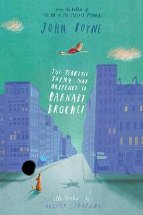The terrible thing that happened to Barnaby Brocket by John Boyne

Doubleday Children's Books, 2012. ISBN 9780857531469.
(Age 13+) Recommended. Barnaby Brocket is unusual - very unusual
indeed. His parents on the other hand, are normal - well, they are in
their own view. In fact, his parents strive so hard to be normal that
they are actually quite abnormal.
John Boyne's new fable is a delightful whimsy about a boy who floats
and the experiences which befall him following a cruel rejection by his
parents.Through Barnaby's story Boyne explores most the theme of
prejudice against those/anything considered 'different' and in
doing so, compels the reader to examine their own perceptions of
'normality'.
Set in Sydney with quite convincing detail (the only jarring note an
episode when the family dog chases a squirrel in the backyard - sorry,
John, we don't have squirrels in Australia), the story unfolds with
examining Barnaby's life till the age of eight, when he is rather
horribly betrayed by his parents. Barnaby finds himself cast adrift
quite literally, floating around the world and meeting all kinds of
wonderful characters who also share the tragedy of rejection by those
who should value them most - their families - simply because of their
'differences'. The reader has ample time to reflect on the adage of not
judging by looks alone, as these new friends of Barnaby's demonstrate
that character and compassion by far outweigh other attributes.
Barnaby's highly developed sense of compassion and sensitivity enable
him to help these various characters - Boyne's deft touch avoids
this becoming cloying sentiment and celebrates a triumph of indomitable
spirit.
With a lovely twist, it becomes gradually clear that the unswerving
'normality' so carefully preserved by Barnaby's parents was in itself
once the subject of rifts between themselves and their own families.
With a definite touch of Roald Dahl's eccentric players and scenarios,
this book is a little hard to define - not least in terms of
readership. There are some trickier concepts which some may prefer to
confine to a more mature reader (e.g. same sex relationships, language,
jokes). The inclination here is to recommend for readers 13+. All in
all, this is a rather delightful and unusual book - this author
continues to impress.
Sue Warren